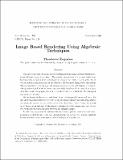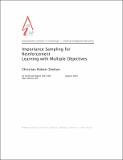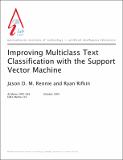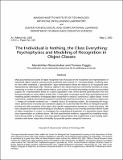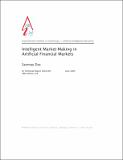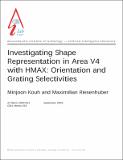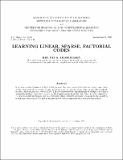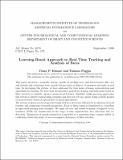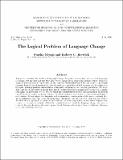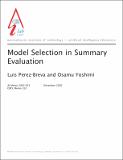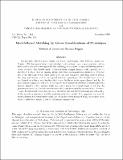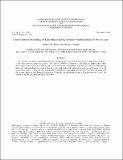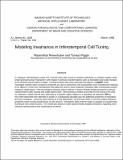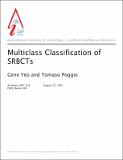Browsing CBCL Memos (1993 - 2004) by Title
Now showing items 48-67 of 123
-
Image Based Rendering Using Algebraic Techniques
(1996-11-01)This paper presents an image-based rendering system using algebraic relations between different views of an object. The system uses pictures of an object taken from known positions. Given three such images it can ... -
Image-Based View Synthesis
(1997-01-01)We present a new method for rendering novel images of flexible 3D objects from a small number of example images in correspondence. The strength of the method is the ability to synthesize images whose viewing position ... -
Importance Sampling for Reinforcement Learning with Multiple Objectives
(2001-08-01)This thesis considers three complications that arise from applying reinforcement learning to a real-world application. In the process of using reinforcement learning to build an adaptive electronic market-maker, we find ... -
Improving Multiclass Text Classification with the Support Vector Machine
(2001-10-16)We compare Naive Bayes and Support Vector Machines on the task of multiclass text classification. Using a variety of approaches to combine the underlying binary classifiers, we find that SVMs substantially outperform Naive ... -
The Individual is Nothing, the Class Everything: Psychophysics and Modeling of Recognition in Obect Classes
(2000-05-01)Most psychophysical studies of object recognition have focussed on the recognition and representation of individual objects subjects had previously explicitely been trained on. Correspondingly, modeling studies have often ... -
Information Dissemination and Aggregation in Asset Markets with Simple Intelligent Traders
(1998-09-01)Various studies of asset markets have shown that traders are capable of learning and transmitting information through prices in many situations. In this paper we replace human traders with intelligent software agents ... -
Intelligent Market-Making in Artificial Financial Markets
(2003-06-01)This thesis describes and evaluates a market-making algorithm for setting prices in financial markets with asymmetric information, and analyzes the properties of artificial markets in which the algorithm is used. The ... -
Investigating shape representation in area V4 with HMAX: Orientation and Grating selectivities
(2003-09-08)The question of how shape is represented is of central interest to understanding visual processing in cortex. While tuning properties of the cells in early part of the ventral visual stream, thought to be responsible for ... -
Learning from Incomplete Data
(1995-01-24)Real-world learning tasks often involve high-dimensional data sets with complex patterns of missing features. In this paper we review the problem of learning from incomplete data from two statistical perspectives---the ... -
Learning Linear, Sparse, Factorial Codes
(1996-12-01)In previous work (Olshausen & Field 1996), an algorithm was described for learning linear sparse codes which, when trained on natural images, produces a set of basis functions that are spatially localized, oriented, ... -
Learning-Based Approach to Estimation of Morphable Model Parameters
(2000-09-01)We describe the key role played by partial evaluation in the Supercomputing Toolkit, a parallel computing system for scientific applications that effectively exploits the vast amount of parallelism exposed by partial ... -
Learning-Based Approach to Real Time Tracking and Analysis of Faces
(1999-09-23)This paper describes a trainable system capable of tracking faces and facialsfeatures like eyes and nostrils and estimating basic mouth features such as sdegrees of openness and smile in real time. In developing this ... -
The Logical Problem of Language Change
(1995-12-01)This paper considers the problem of language change. Linguists must explain not only how languages are learned but also how and why they have evolved along certain trajectories and not others. While the language ... -
Measure Fields for Function Approximation
(1993-06-01)The computation of a piecewise smooth function that approximates a finite set of data points may be decomposed into two decoupled tasks: first, the computation of the locally smooth models, and hence, the segmentation ... -
Model Selection in Summary Evaluation
(2002-12-01)A difficulty in the design of automated text summarization algorithms is in the objective evaluation. Viewing summarization as a tradeoff between length and information content, we introduce a technique based on ... -
Model-Based Matching by Linear Combinations of Prototypes
(1996-12-01)We describe a method for modeling object classes (such as faces) using 2D example images and an algorithm for matching a model to a novel image. The object class models are "learned'' from example images that we call ... -
Model-Based Matching of Line Drawings by Linear Combinations of Prototypes
(1996-01-18)We describe a technique for finding pixelwise correspondences between two images by using models of objects of the same class to guide the search. The object models are 'learned' from example images (also called ... -
Modeling Invariances in Inferotemporal Cell Tuning
(1998-03-01)In macaque inferotemporal cortex (IT), neurons have been found to respond selectively to complex shapes while showing broad tuning ("invariance") with respect to stimulus transformations such as translation and scale changes ... -
Modeling Stock Order Flows and Learning Market-Making from Data
(2002-06-01)Stock markets employ specialized traders, market-makers, designed to provide liquidity and volume to the market by constantly supplying both supply and demand. In this paper, we demonstrate a novel method for modeling ... -
Multiclass Classification of SRBCTs
(2001-08-25)A novel approach to multiclass tumor classification using Artificial Neural Networks (ANNs) was introduced in a recent paper cite{Khan2001}. The method successfully classified and diagnosed small, round blue cell tumors ...

